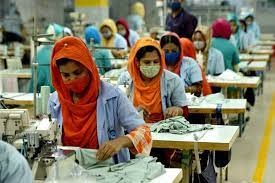Key Challenges in Accessing Schemes by Garment Sector Workers
LessGarment estimationSector ofUnderrepresentation: garmentUnveiling workers:the Disparity
- CIVIDEP,
one of oura partnerorganizations,organization,highlightssheds light on the significant issue of the underrepresentation of garment sector workers in the broader workers' database.OfficialWhile official government recordssuggestindicate a count of 90,000 workers in the sector,butthethestark realityis that there arereveals over 1,500 factoriesin the sectoremployingataleastminimum of 5,000 garment workers. In the bustling city of Bangalore alone,therethearegarmentapproximatelyindustry sustains around 4 lakhgarment sectorworkers, with a notable 85%of them beingcomprising women. This glaring underrepresentationposesnotchallenges,onlypotentiallysignifiesresultingainsubstantialfewerworkforceaccessiblebut also raises concerns about the accessibility of welfare schemes andathe lack of adequate advocacy for the rights andwelfarewell-being of theseworkers.vital contributors to the sector.
IdentityESI ofAccessibility garmentChallenges: sector workers:
UnlikeGarment industry employees encounter hurdles with the Employees' State Insurance (ESI) scheme. Limited benefits and accessibility issues are notable concerns. Obtaining leave for ESI hospital visits is difficult due to stringent work conditions and production targets, hindering workers from utilizing ESI benefits fully.
Challenges in sectorsProvident suchFund as(PF) construction,and thoseGratuity Processes for Garment Workers:
-
Understanding and accessing Provident Fund (PF) and gratuity can be tricky for garment workers, especially when they change jobs between different companies. The problem arises because these job shifts disrupt the smooth process of receiving PF and gratuity benefits.
-
To complicate matters further, some factories play a tricky game. When the time for gratuity is approaching, they might ask workers to resign and rejoin. Why? It's a way for the factories to avoid paying the gratuity they owe. This not only adds confusion to the process but also highlights how workers face challenges in securing their rightful financial benefits when changing jobs in the garment industry.
Casual Leave Restrictions:
- Despite being entitled to a weekly off, garment sector workers face restrictions on availing casual leaves. Stringent policies around casual leaves limit flexibility, impacting work-life balance and overall well-being.
Vulnerability of Pregnant Workers:
- Pregnant women in the garment industry
lackencounteravulnerabilitycleartoemployeeworkplaceidentity.pressures,Despiteincludingbeingcoercionregisteredtowithresign. The absence of supportive policies contributes to job insecurity, adversely affecting theEmployees'overallProvidentwelfareFundofOrganizationwomenandin theEmployees' State Insurance Corporation, their formal classification does not correspond with the notably low salaries or wages they receive as formal sector workers.sector.
Decade-Long Stagnation and Inadequate Compensation
- The remuneration structure for garment sector workers presents a persistent challenge, with the minimum pay stagnating for over a decade. Despite dedicating 10-15 years to the industry, workers find themselves earning a meager Rs 10,000 per month. This lack of upward revision in wages not only hampers financial stability but also reflects a broader issue of insufficient compensation for the expertise and experience these workers bring to the sector. Such challenges in pay significantly impact the quality of life for garment industry workers, making it difficult for them to meet basic living expenses and hindering their socio-economic progress.
Unpaid Overtime and High Production Pressure:
- Garment industry workers typically endure an 8-hour shift, but the challenges extend beyond the standard workday. The demand for meeting production targets often leads to unpaid overtime work, with employees compelled to rectify 'mistakes' in the manufacturing process. This expectation of extended working hours not only places a burden on the physical well-being of the workers but also contributes to heightened levels of fatigue and stress. Additionally, the emphasis on meeting production quotas can foster a high-pressure work environment, impacting the overall cohesion among workers. This creates a challenging dynamic where individuals are pushed to work beyond regular hours without adequate compensation, affecting both their personal lives and job satisfaction.
Duality in Formal Classification: Informality Challenges Faced by Garment Sector Workers
While garment sector workers are officially classified as part of the "Formal Sector," their working conditions and practices often mirror those found in the informal sector. Despite the formal classification, several aspects contribute to the similarity with the informal sector:
- Low Wages: Garment sector workers, despite being in the formal sector, frequently face low wages that may not align with the industry's demands and the cost of living.
- Job Insecurity: Contractual employment is prevalent, leading to job insecurity. Workers may not have long-term job stability, and layoffs or terminations can occur without proper job protection.
- Lack of Unionization: In many cases, garment sector workers lack strong unions within the factories. This absence of collective bargaining power limits their ability to advocate for improved working conditions and rights.
- Exploitative Practices: Instances of verbal and physical abuse, exploitative work practices, and inadequate safety measures are reported, reflecting conditions often associated with the informal sector.
- Limited Social Security Benefits: Access to social security benefits, such as health insurance, provident funds, and other formal employment perks, may be restricted or insufficient for many workers.
- Informal Work Arrangements: Some garment workers face informal work arrangements, where verbal agreements and understanding rather than written contracts dictate terms of employment.
In essence, despite the formal classification, the challenges and practices experienced by garment sector workers often align more closely with those in the informal sector. This duality reflects the complexities and shortcomings within the formalization of certain industries

